John Deere 5090R Tractor
5 Series Utility Tractors
Your Preferred Location
Features
-
PTO HP: 77.5 hp (57.8 kW)
-
Engine HP: 90 hp (66 kW)
-
2WD or 4WD: 4WD
-
Economy PTO: Yes
-
Cab or Open Station: Cab
-
Hitch Category: Category 2<br /> (convertible to 1)
Specifications
Capacities - Cooling system: |
|
Capacities - Fuel tank: |
Standard: 144 L 38 U.S. gal. |
Dimensions - Approximate shipping weight, Open;Cab: |
MFWD: 4450 kg 9811 lb |
Dimensions - Wheelbase: |
MFWD: 2250 mm 88.6 in. |
Electrical system - Type of bulb in beacon (Halogen, Zenon, LED): |
|
Electrical system - Type of bulb in headlight (Halogen, Zenon, LED): |
|
Engine performance - PTO torque rise: |
At 1600 rpm: 36 rpm |
Engine performance - Rated power: |
At 2200 per ISO 97/68/EC: 66 kW 90 engine hp |
Engine performance - Rated PTO power (hp SAE): |
At 2100 per SAE: 57.8 kW 77.5 PTO hp |
Engine specifications - Aspiration: |
Turbocharged/air-to-air aftercooled |
Engine specifications - Cylinders liners: |
Wet sleeved |
Engine specifications - Description: |
John Deere 4045 PowerTech PWL |
Engine specifications - Displacement: |
4 cylinders: 4.5 L 276 cu in. |
Engine specifications - Engine family: |
FJDXL04.5211 |
Hydraulic system - Available flow at a single rear SCV: |
Standard: 73 L/min 19.3 gpm Optional: 100 L/min 26.4 gpm |
Hydraulic system - Joystick SCV control: |
Optional |
Hydraulic system - Pump rated output: |
Standard: 96.6 L/min 25.5 gpm Optional: 117.3 L/min 31 gpm |
Hydraulic system - Type: |
Standard: Open Center Optional: Pressure-and-flow compensated (PFC) system |
Key Specs - Engine description: |
John Deere 4045 PowerTech™ PWL |
Key Specs - Engine displacement: |
4 cylinders: 4.5 L 276 cu in. |
Key Specs - Hydraulic pump rated output: |
Standard: 96.6 L/min 25.5 gpm Optional: 117.3 L/min 31 gpm |
Key Specs - Rated engine power: |
At 2200 per ISO 97/68/EC: 66 kW 90 engine hp |
Key Specs - Rated PTO power (hp SAE): |
At 2100 per SAE: 57.8 kW 77.5 PTO hp |
Key Specs - Rear hitch category (SAE designation): |
Category 2/1 |
Key Specs - Transmission type: |
Standard: 16F/16R CommandQuad™ manual Optional: 16F/16R CommandQuad manual with creeper 32F/16R Command8™ |
Miscellaneous - Country of manufacture: |
Augusta, GA |
Operator station - dB(A) rating: |
73 dBA |
Operator station - Rollover protective structure, OOS: |
|
Operator station - Seat: |
|
Rear axle - Axle type: |
Flanged |
Rear axle - Brakes, type and control: |
Hydraulic wet disc |
Rear axle - Differential controls: |
Electrohydraulic |
Rear axle - Final drive type: |
Inboard planetary |
Rear hitch - Hitch category (SAE designation): |
Category 2/1 |
Rear hitch - Hitch draft control load sense type: |
Electrohydraulic |
Rear hitch - Maximum lift capacity behind lift points: |
Standard: 3038 kg 6697 lb Optional: 3564 kg 7857 lb |
Rear hitch - Remote control valves available: |
Two, up to four total |
Rear hitch - Sensing type: |
Lower link |
Rear power take-off (PTO) - Engine rpm (at rated PTO speeds): |
540 at 2100 rpm 540E at 1645 rpm 1000 at 2103 rpm |
Rear power take-off (PTO) - PTO actuation: |
Electrohydraulic |
Rear power take-off (PTO) - Type: |
Standard: 540/540E/1000 |
Tires - Front: |
MFWD: 12.4R24 (320/85R24) R1W Radial |
Tires - Rear: |
18.4R30 R1W Radial |
Tires - Turning radius with brakes: |
MFWD: 3.37 m 11.1 ft |
Tires - Turning radius without brakes: |
MFWD: 3.7 m 12.1 ft |
Tires - Wheel tread range: |
MFWD: 1148-2000 mm 45.2-78.7 in. |
Transmission - Clutch; wet/dry: |
Wet |
Transmission - Creeper: |
16F/16R CommandQuad manual with creeper |
Transmission - Reverser: |
Standard: Left hand, electronic Optional: Joystick reverser |
Transmission - Type: |
Standard: 16F/16R CommandQuad manual Optional: 16F/16R CommandQuad manual with creeper 32F/16R Command8 |
Weight - Base machine weight: |
Boost utility tractor productivity with AutoTrac™ guidance
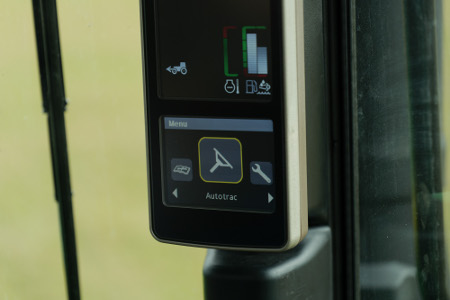 AutoTrac in the tractor display
AutoTrac in the tractor display
5R Tractors can be ordered with AutoTrac integrated in the tractor display.
AutoTrac is a great solution if you are looking for a lower-cost integrated guidance system for your utility tractor. For the straight track only feature, you will no longer need an additional display or display activation. When a 5R Utility Tractor is ordered with AutoTrac Ready (code 1803), the AutoTrac screen is included; all you need to add is a StarFire™ 6000 Receiver (code 1840).
Benefits of AutoTrac on the tractor display:
- Simple and user friendly
- Total cost of integrated AutoTrac is 36 percent lower by eliminating the need for a precision ag display
- Reduces startup costs with no display activation or subscription fees
- Reduces operator fatigue
- Eliminates implement overlap and optimizes machine efficiency
5R Tractors can also be factory equipped with a 4240 Universal Display (code 8076) that transitions AutoTrac guidance from the tractor display to the Gen 4 4240 Universal Display for additional capabilities:
- On-screen mapping
- Documentation
- Section Control
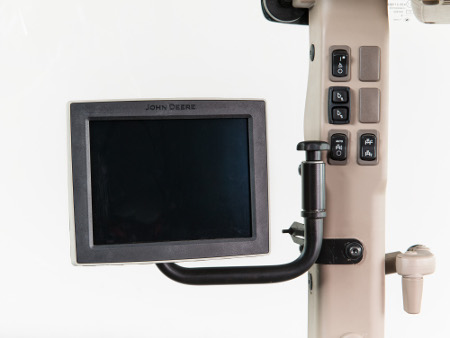 Gen 4 4240 Universal Display
Gen 4 4240 Universal Display
NOTE: Once the 4240 is disconnected, the tractor display will be re-activated.
Standard AutoClutch™ system for clutchless operation
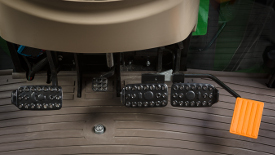 Brake pedals
Brake pedals
With AutoClutch, which is standard on all 5R Utility Tractors, the operator no longer has to use the clutch to control braking and re-engagement of the tractor if so desired. The clutch pedal is still on the tractor for those operators that still prefer to manually foot clutch. This provides the ultimate in ease of use, especially in applications where precise control and more stopping /starting is required.
AutoClutch allows the operator to bring the tractor to a complete stop without clutching, while at the same time does not overload the engine. It also provides the ability to inch or creep the tractor forward or reverse on a level surface or incline. Being able to inch or creep the tractor is an important tool for more efficient front and rear implement hookups. AutoClutch also provides the ability to accelerate the vehicle back to normal speed when releasing the brake.
 AutoClutch settings in cornerpost display
AutoClutch settings in cornerpost display
The operator can set the sensitivity setting of the AutoClutch system in the cornerpost display. There are three modes available:
- High sensitivity (default mode)
- Medium sensitivity
- Low sensitivity
- Off – temporary setting only that is reset after a key cycle
Low sensitivity would be typically used in transport applications with a towed implement. The low sensitivity ensures that the tractor and implement are stretched for better traction control.
Maximum fluid efficiency with Final Tier 4 (FT4) engines
The U.S. Environmental Protection Agency Agency (EPA) and Environment Canada requires all off-road diesel engines with 18.6 kW (25 hp) or more to meet stringent FT4 emissions regulations. John Deere uses the most efficient and cost-effective solution for the tractor package to meet emissions requirements at each horsepower level.
The engine powering the 5R is EPA certified Tier Level 4. This is achieved through a combination of a diesel oxidation catalyst (DOC) and selective catalytic reduction (SCR) using diesel exhaust fluid (DEF, or urea).
Several defining features on the 5R maximize the performance and reliability of the emissions package. A completely shielded DOC/SCR not only protects essential components from damage, it also keeps out dirt and debris. The well-packaged and tightly organized circulation system means there is more room to work around the tractor.
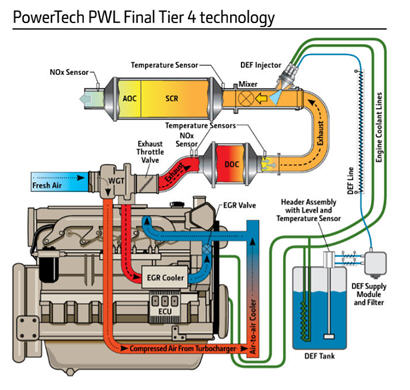 PowerTech™ PWL Final Tier 4 technology
PowerTech™ PWL Final Tier 4 technology
Key components of the emissions system include:
DOC
John Deere has chosen to utilize an DOC to reduce NOx to create less particulate matter. By no longer including a diesel particulate filter (DPF) and increased efficiencies in other areas of the tractor, the result is improved total fluid economy (diesel and DEF) and a lower cost to the producer.
The engine is programmed to aggressively respond to changes in power needs, which can temporarily increase particulate matter. Since the DOC removes particulate matter instead of the engine, the engine is left free to do what it is designed to do – deliver all of the power, torque, plus transient response needed.
DEF
DEF is an ISO 22241 standard aqueous urea solution consisting of 32.5 percent urea and has a freezing point of -11°C (12°F). A 11.4-L (3-gal.) heated DEF tank used in conjunction with a 143.8-L (38-gal.) fuel tank keeps the operator in the field longer. A DEF tank heater is integrated with a temperature sensor, and plumbed engine coolant lines are used to promote thawing and prevent freezing in the tank during cold operation.
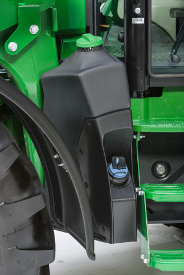 DEF tank
DEF tank
The electronic control unit (ECU) controlled supply module draws DEF from the storage tank 11.4 L (3-gal.) and provides a pressurized flow to the dosing module. When the ignition key is off, the supply module pump will reverse direction to return any accumulated fluid back to the tank. The supply module is also fitted with a replaceable filter to prevent contaminants from entering the dosing lines. Both the supply module and dosing lines are electrically heated and controlled by the ECU to determine when DEF dosing can begin.
The dosing module is cooled by engine coolant and used to inject DEF at a pressure of 130 psi (900 kPa, 9 bar) into the decomposition tube. A harness is connected to the dosing valve that relays the needed DEF to inject based upon the amount of NOx exiting the DOC measured from the NOx tube sensor.
The decomposition tube is the internal mixing device used to circulate DEF with engine exhaust prior to entering the SCR/AOC after-treatment device.
SCR
To reduce the NOx, DEF is injected into the exhaust stream. When the exhaust gases combine with the DEF in the SCR catalyst, the NOx is broken down into nitrogen and water vapor.
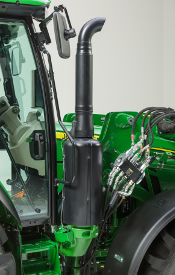 SCR location on the 5R Tractor
SCR location on the 5R Tractor
Exhaust gas recirculation (EGR)
EGR reduces the high temperatures where these compounds are formed in the engine cylinders by replacing excess oxygen with a prescribed amount of cooled exhaust gas.
Exhaust gases contain more carbon dioxide than oxygen. The EGR valve, in conjunction with the venturi tube, and engine control unit (ECU), allow a controlled amount of exhaust gas to enter the intake manifold to mix with the incoming fresh air.
Replacing excess oxygen with cooled exhaust gas leads to:
- Lower combustion temperatures, creating less NOx.
In addition, EGR allows for:
- Advanced timing
- Optimal engine performance
- Maximum fuel economy
For added performance and efficiency, the engine passes the exhaust gases through an EGR cooler before it enters the engine.
Exhaust airflow enters into the EGR cooler from the exhaust manifold near the turbocharger. Based on engine load, air temperatures, and rpm, the ECU opens or closes the EGR valve, allowing a measured percentage of exhaust gas to enter the intake manifold. The gases mix with the rest of the incoming air from the turbocharger and aftercooler before entering the cylinders.
Turbocharged engine
The PowerTech PWL 4.5L utilizes one turbocharger — a fixed geometry, wastegate turbocharger. Fresh air is first drawn into the low-pressure fixed geometry, wastegate turbocharger, and compressed to a higher pressure. The compressed air is then routed to the charge air cooler and then to the intake manifold.
Benefits of air-to-air aftercooling
- Lowers the intake manifold air temperature
- Provides more efficient cooling while reducing temperatures for greater engine reliability
- Higher volume of air flows into the cylinders
- Engine is capable of meeting the increasing horsepower demands
Combustion process with externally cooled EGR
Functions:
- According to engine operating conditions, the recirculated exhaust gases reduce the oxygen portion in the intake air to approximately 20 percent. Without any increase of the charge air pressure, the oxygen rate is not high enough to ensure a complete combustion of the fuel injected at high engine loads.
Advantages:
- Fuel-efficient combustion is achieved, because sufficient oxygen is provided.
A restrained, cooler combustion is realized, since the typical hot combustion process, which is generated by an oxygen surplus, is dampened by the inert exhaust gases. Hence, NOx emissions are reduced.
For more information regarding EPA regulations and the technology behind John Deere Integrated Emissions Control systems, please visit the following link:
http://www.deere.com/wps/dcom/en_US/campaigns/ag_turf/emissions/final_tier_4.page
Industry-leading maneuverability
Utility tractor users often work in challenging environments, including in and around barns, fields, or livestock areas. Maneuverability is a priority as space can be limited at times. Implementing the single-piece mid-frame designs and the structural oil pan enabled the wheelbase of the 5R to shrink by 100 mm (4 in.) when compared to the Final Tier 4 (FT4) 5M Tractors.
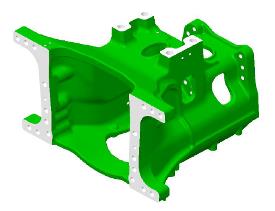 Single-piece mid frame
Single-piece mid frame
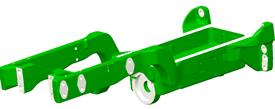 Structural oil pan
Structural oil pan
The shortened 2250-mm (88.6-in.) wheelbase provides best-in-class turning with a 12.1 turning radius without the use of turning brakes. This calculation uses 13.6R24 front tires, which provide 58 degrees of turning angle and a full 10 degrees of axle oscillation.
Power bulge and torque reserve pull through the tough spots
Putting more power to the ground translates to increased productivity in demanding conditions. Simply put, torque is the useable power that can be achieved. More torque leads to more lugging ability which helps the operator be more productive.
5R Final Tier 4 (FT4) engines feature up to an 8 percent power bulge when put under load. The power bulge feature of the electronically controlled engine delivers additional horsepower as engine rpm drops below rated speed. Additionally, a 36 percent torque rise provides the force that maintains horsepower as engine rpm drops below rated speed.
When the tractor is under load, power bulge and torque rise work together to get through the tough spots and reduce the need to downshift. Horsepower and torque are mathematically related.
 |
As rpm drops, the only way to maintain or increase horsepower is to provide additional torque. The output horsepower is greater than or equal to rated horsepower as the engine is pulled down to 1750 rpm.
The peak torque rise also occurs near the rated economy power take-off (EPTO) speed for enhanced performance when operating in 540E power take-off (PTO).
NOTE: 5RH – 5115 hp only.
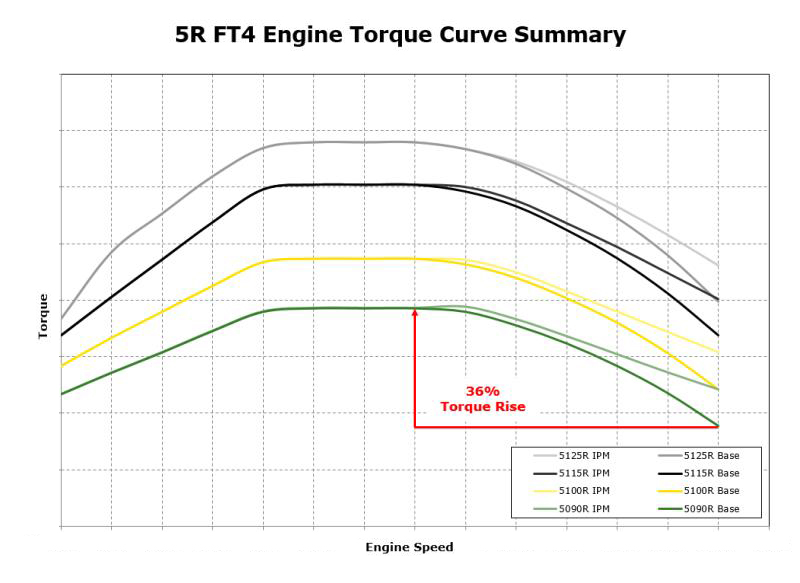 5R torque curve summary
5R torque curve summary
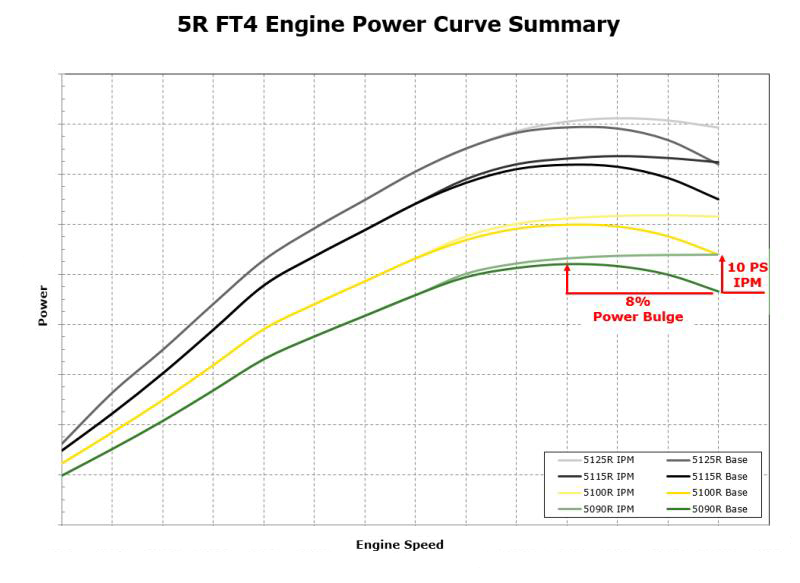 5R engine power curve summary
5R engine power curve summary
Improve operator comfort with integrated loader joystick controls
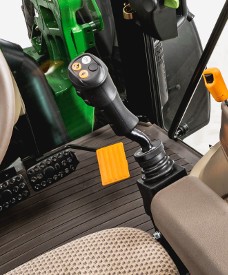 Mechanical loader joystick
Mechanical loader joystick
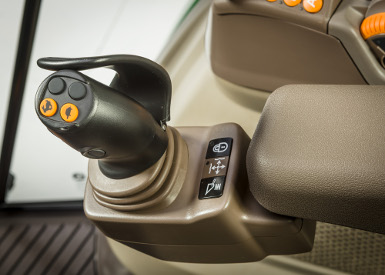 Electrohydraulic loader joystick
Electrohydraulic loader joystick
There are two types of loader joysticks available on 5R Tractors: mechanical and electrohydraulic. Whether you select the CommandQuad™ Manual, CommandQuad™ Auto, or Command8™ transmission, gear shifting and directional change is included as base equipment on any 5R Tractor that is equipped with mid selective control valves (SCVs).
- Both mechanical and electronic joystick options are mounted to the swivel seat.
- The mechanical joystick is available with either open center or pressure-and-flow compensated (PFC) hydraulics.
- Gear selection buttons are on top of the joystick for ease of shifting.
- The operator can press and hold the gear buttons to accelerate quickly through the gears when in multirange selections (BCD or CD).
- Both joysticks have a reverser button on the side for directional change.
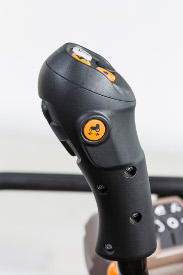 Mechanical joystick with reverser
Mechanical joystick with reverser
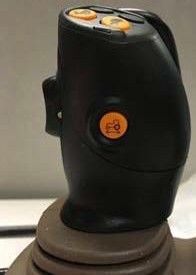 Electrohydraulic joystick with reverser
Electrohydraulic joystick with reverser
Operating a loader tractor has never been easier. Either joystick option makes loader operation extremely comfortable during long days of moving hay bales, stacking pallets, or general loader work.
5R Tractors with the CommandARM™ console and electrohydraulic mid SCVs have reassignable joystick functionality. See detailed features for additional information.
Intuitive digital cornerpost display
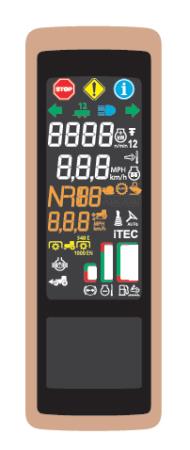 Digital cornerpost display
Digital cornerpost display
The digital cornerpost display features state-of-the-art electronic instrumentation and blends well with the narrow right-hand cab post. This intuitive design eliminates the instrument cluster once surrounding the steering column while increasing forward facing visibility. In addition to displaying machine information, the cornerpost display also serves as the primary interface between the tractor and operator when adjusting hitch, transmission, hydraulic, and engine settings.
Information included in the display:
- Stop, service, and information alerts
- Exhaust filter cleaning indicator
- Engine rpm (engine speed)
- Fuel-level gauge with low-fuel warning
- Diesel exhaust fluid (DEF) level indicator
- Engine temperature gauge
- Power take-off (PTO) engaged indicator
- Range information (F, N, R, P), transmission range and gear indicator
- Gear and AUTO mode indication
- Ground speed
- Target speed (in AUTO mode)
- Field cruise
- Differential lock indicator
- Mechanical front-wheel drive (MFWD) indicator
- Turn signal and hazard indicators
- High-beam indicators
- Start aid time remaining (with electric air intake heater)
- Creeper indication (if equipped)
- iTEC™ system indication (if equipped)
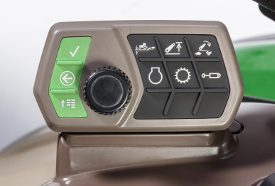 Cornerpost display interface
Cornerpost display interface
Interaction with the cornerpost display is primarily controlled with a button module mounted at the front of the right-hand upholstery. On the left side in green are a check mark button used to select items, a left arrow button that serves as a back button, and a menu button. The black wheel in the center is used for toggling within screens or adjusting settings.
To the right of the scroll wheel are hot buttons for frequently controlled settings, including draft control, hitch raise height, hitch drop rate, engine settings, transmission settings, and hydraulic settings. These buttons serve as shortcuts to make adjusting more common settings quicker and easier to access.
Optional CommandARM™
Take command of the 5R Tractor with the optional CommandARM console. Bring the functionality of selective control valves (SCVs), power take-off (PTO) engagement, hitch adjustment, and loader controls to one common place while still having the functionality to swivel the seat. Integrating large tractor technology into the 5R Series, operators will notice common features such as easily identifiable SCVs with color coding as well as the PTO engagement switch.
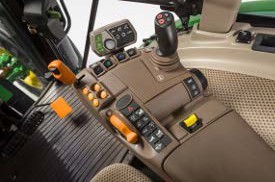 CommandARM console
CommandARM console
CommandARM provides individual access to the most frequently used controls.
- Engine throttle
- Transmission controls
- Electrohydraulic PTO
- Hitch/SCV controls (up to four rear SCV’s)
- Primary display unit (PDM)
- Loader joystick
Cab suspension provides premium comfort
For operators wanting superior comfort and smoother driving, mechanical cab suspension is available for the 5R Series Tractors. The mechanical cab suspension reduces operator fatigue and improves comfort, especially when operating long hours in uneven fields. While offering a smoother ride, this factory-installed option also reduces noise and vibrations inside the cab from the engine, transmission, chassis, and implements one may be operating.
The cab rests on two rubber isolators at the front and two fully integrated shock absorbers at the rear which dampen the vibrations coming through the frame. The system provides stability to monitors in the cab helping to keep them in your viewing area.
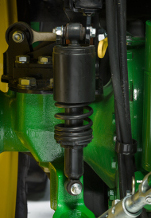 5R optional cab suspension
5R optional cab suspension
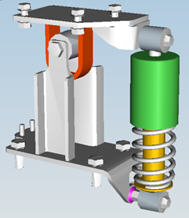 Mechanical cab suspension with mounting
Mechanical cab suspension with mounting
Premium cab with high visibility panorama roof for the ultimate operating experience
The premium cab is designed to provide superior visibility for the ultimate operating experience, especially in front loader applications. This cab includes all of the features of the standard cab operator station plus much more. Some of the key features include:
- Panoramic sunroof with sliding top shade and pull down front sunshade
- Factory-installed radio
- Bluetooth® system ready
- Satellite capable
- Deluxe sound system with front-corner-mounted speakers and subwoofer
- USB port (for sound only)
- Auxiliary cord connection
- Additional interior cab light
- Rear windshield wiper
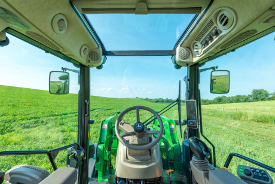 Premium panorama cab
Premium panorama cab
Visibility
Featuring a single-piece front windshield, forward facing visibility has improved by 7 percent for easier loader attachment hookups and easier following of rows in vegetable and other row-crop applications. Upward visibility has improved 80 percent with the panorama roof in the premium cab, providing for easier bale stacking, pallet stacking, and dumping loads into walled trailers.
For improved ease of use and visibility in both sunny and adverse weather conditions, the premium cab comes standard with several tools to help get the job done. To shield the operator from the sun on bright days, an easy-to-use sliding overhead sunshade with an integrated front pull-down shade is provided. To provide additional visibility in adverse conditions, such as rain or fog, the premium cab comes standard with a factory-installed rear window wiper, and exhaust vents built into the back of the front-mounted speakers.
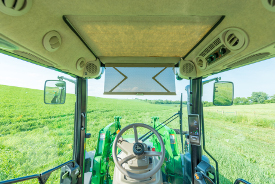 Panoramic sunroof with sliding top shade and pull-down front sunshade
Panoramic sunroof with sliding top shade and pull-down front sunshade
Sound and radio
Standard factory-installed radio is Bluetooth ready and has satellite capability. The premium cab also offers a deluxe sounds system with front-corner- mounted speakers and a subwoofer behind the seat for enhanced sound performance. The satellite radio capability feature makes it easy for operators to connect the sound system to SiriusXM® radio. The premium cab comes with a Bosch® deluxe radio, and offers both an auxiliary and a USB port to connect custom electronic devices. Using the Bluetooth feature, customers are able to connect to their phones to the radio providing wireless connectivity. Integrated into this deluxe sound system is an additional interior cab light in the bottom of the left-corner-mounted speaker.
 Factory-installed radio
Factory-installed radio
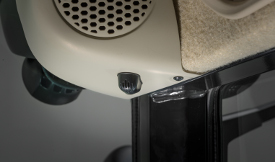 Bluetooth microphone
Bluetooth microphone
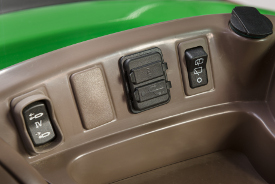 Auxiliary cord connection
Auxiliary cord connection
Bluetooth is a trademark of Bluetooth SIG Incorporated. Bosch is a trademark of Robert Bosch GmbH. Sirius XM is a trademark of Sirius XM Radio Inc.
CommandQuad™ Manual transmission provides fully electronic range and gear shifting
CommandQuad Manual transmission is base equipment on 5090R, 5100R, 5115R, and 5125R Tractors
The CommandQuad Manual transmission expands the proven reliability of the PowrReverser™ transmission with a 4-range, 4-speed transmission that enhances operator convenience and productivity through fully electronic manual range and gear shifting. The CommandQuad Manual uses the same final drives, rear axle, and differential as the already proven 5M PowrReverser transmissions. Rather than using mechanical synchronizers, the CommandQuad Manual utilizes powershift clutches. Also, electrohydraulic cylinders move the shift rails instead of a mechanical lever. This provides excellent ease of use and more efficient operation.
The CommandQuad Manual transmission is equipped with 16 forward and 16 reverse (16F/16R) speeds, a left-hand reverser, and four powershiftable gears in four fully synchronized ranges. The CommandQuad Manual transmission also comes with open centered hydraulics in base equipment, with the ability to option up to pressure and flow compensating (PFC) hydraulics from the factory. The base CommandQuad Manual transmission operates at speeds as slow as 1.9 kph (1.18 mph) with rolling circumference index (RCI) group 44 rear tires, and speeds up to 40 kph (25 mph).
For even slower speed options, a creeper is available as a factory-installed option (requires PFC hydraulics).
CommandQuad ground speed chart
CommandQuad with creeper ground speed chart
Operating the CommandQuad Manual transmission
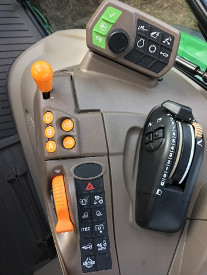 CommandQuad shift controls
CommandQuad shift controls
Range/gear controls
A single control lever, similar to the control used on the DirectDrive™ on 6R and CommandQuad™ on 7R, features an ergonomically designed and intuitive operator interface. This control lever provides manual gear and range change selection. This base transmission, although similar in operation to the optional Command8™ transmission, does not offer any automatic shifting capabilities.
Once the tractor is started, the operator selects a range by pressing one of the lettered range buttons on the right-hand console. The operator has five different selections to choose from - A, B, C, and two multi-range modes (BCD and CD). When a range with a single letter is selected, gear shifting is allowed within the specified range. When a range with multiple letters is selected, operators can shift between the designated ranges simply by using the toggle lever.
The gear within the range can be selected by using the transmission control toggle lever to electronically shift to a desired gear. After setting the desired throttle position, the operator can move the left-hand reverser to the forward or reverse position to start movement. The operator can shift up or down through the gears in the selected range(s) as needed.
The operator has the ability to shift through speeds and ranges without clutching by moving the toggle lever forward, toward the + indicator, or backward, toward the - indicator. A single movement of the toggle lever changes one gear at a time. Holding the toggle lever in either direction increases accelerates gear changes throughout the range at a faster pace.
When in a multi-range mode, a simple double toggle of the lever moves to the next range.
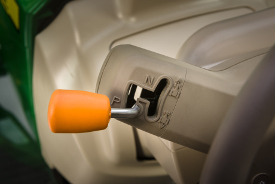 Left-hand reverser
Left-hand reverser
Left-hand reverser
The electronic left-hand reverser is standard with all CommandQuad Manual transmissions and provides neutral-to-gear modulation, which allows a quick, convenient, and smooth forward-reverse shuttle shifting at any speed. The shifter must be lifted from either park or neutral position to forward or reverse to activate. The parking brake is also electronically controlled through the left-hand reverser.
The left-hand reverser is a great feature for loader tractors. The operator's left hand can control easily tractor direction while the right hand manages the loader joystick and speed changes.
Independent programmable forward/reverse ratio
This feature is helpful in cyclical operations, such as loader work, where the operator wants to control the forward speed as a ratio of the reverse speed.
In manual mode, the tractor automatically selects a gear closest to the ratio desired by the operator. In auto mode, the tractor would adjust the set speed in the opposite direction. Ratios can be programmed up to 100 percent faster than the forward speed or up to 80 percent slower than the forward speed within the cornerpost display. This is adjustable in 20 percent increments (forward speed x 0.20, 0.40, 0.60, 0.80, 1.00, 1.20, 1.40, 1.60, 1.80, 2.00).
Another selection is independent; in this mode the tractor remembers the last forward and reverse gear setting. Once the gear is manually changed in the reverse direction, the gear will automatically go back to the last gear when changing directions. If the gear is not manually changed when in reverse direction, then the forward gear and reverse gear will remain the same when changing directions.
While the maximum forward ground speed is 40 km/h (25 mph), the maximum reverse speed is 30 km/h (18.6 mph).
Standard advanced features of the CommandQuad Manual transmission
AutoClutch
With AutoClutch, which is standard on all 5R Utility Tractors, the operator no longer has to use the clutch to control braking and re-engagement of the tractor if so desired. The clutch pedal is still on the tractor for those operators that still prefer to manually foot clutch. This provides the ultimate in ease of use.
AutoClutch allows the operator to bring the tractor to a complete stop without clutching, while at the same time does not overload the engine. It also provides the ability to inch or creep the tractor forward or reverse on a level surface or incline. And it provides the ability to accelerate the vehicle back to normal speed when releasing the brake.
The operator can set the sensitivity setting of the AutoClutch system in the cornerpost display. There are three modes available:
- High sensitivity (default mode)
- Off – temporary setting only that is reset after a key cycle
- Low sensitivity
Low sensitivity would be typically used in transport applications with a towed implement. The low sensitivity ensures that the tractor and implement are stretched for better traction control.
Speed matching
When shifting ranges in a multi-range mode (BCD, CD), the transmission will shift to a gear that most closely matches the speed in the range from which the operator is shifting from, which improves operator comfort by making a smoother transition into a new range. There are two types of speed matching, passive and active.
With passive speed matching, when shifting to a new range, the tractor shifts to a selected fixed gear in the new range based on transmission ratios. For example, when shifting from C4 to D range, instead of shifting into D4 when the range is changed to D like a mechanically controlled transmission would do, the transmission shifts to a preset range and gear within range D. This most closely matches the transmission ratio from which the operator is coming from.
Active speed matching shifts up or down based on wheel speed during range shifts. This minimizes acceleration or deceleration when the clutch re-engages after a range shift and keeps a more consistent ground speed, improving operator comfort.
PowrReverser modulation
Similar to the 5M Utility Tractors, which offer a PowrReverser modulation dial to set aggressiveness of change in direction, all 5R Utility Tractors also offer PowrReverser modulation. Rather than a physical dial, the aggressiveness can be set through the cornerpost display. Settings can be set from 1 to 10, with 1 being the least aggressive direction change and 10 being the most aggressive direction change. A setting of 10 is popular for loader bucket applications where quicker directional changes are acceptable and more productivity is desired. Less aggressive modulation settings are ideal where smoother directional changes are required, such as bale stacking and pallet fork activities.
Start gear selection
Starting within gear 1 within every range has a negative impact on productivity. To minimize the amount of shifting required by the operator in many applications, start gears can be programmed by the operator when operating in any of the two multi-range modes.
In range CD, any start gear can be programmed into the cornerpost display between C1 and D1. In range BCD, any start gear can be programmed between B1 and D1. Let’s say that an operator programs B4 as the start gear for BCD range. Anytime the operator selects BCD mode by pressing that particular range button, the tractor will automatically begin in gear B4. The operator can of course shift to any range and gear between B1 and D4 from there, but the starting point will be what the operator has programmed. This results in less shifting and more productivity.
Within the fixed ranges (A, B, C), the preset start gears are A4, B4, and C4. These cannot be altered by the operator through the cornerpost display.
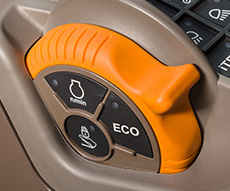 Foot pedal lock switch
Foot pedal lock switch
Foot pedal lock
Similar to cruise control in a car, the foot pedal lock allows the operator to set a constant speed using the foot pedal. The switch to engage foot pedal lock is also located on the right-hand throttle control. To operate the feature, the hand throttle must be on the low throttle position. Use the foot throttle to increase the tractor to the desired travel speed, and then press the button to engage the foot pedal lock. When releasing the foot throttle, the tractor will then maintain the speed selected. It can be disengaged by either tapping the brakes, or moving the left hand reverser control to neutral or park.
Command8™ transmission for premium ground speed and load management
Command8 transmission is optional on 5R Tractors
The Command8 transmission expands the proven reliability of the PowrReverser™ transmission with a 4-range, 8-speed transmission that enhances operator convenience and productivity through fully electronic range and gear shifting, as well as automatic shifting capabilities. The Command8 uses the same final drives, rear axle, and differential as the already proven 5M PowrReverser transmissions. Rather than using mechanical synchronizers, the Command8 utilizes powershift clutches. Also, electrohydraulic cylinders move the shift rails instead of a mechanical lever. This provides excellent ease of use and more efficient operation.
The Command8 transmission is equipped with 32 forward and 16 reverse (32F/16R) speeds, a left-hand reverser, and eight powershiftable gears in four fully synchronized ranges. The Command8 transmission also comes with pressure and flow compensating (PFC) hydraulics in base equipment. The Command8 operates at speeds as slow as 1.9 km/h (1.18 mph) with rolling circumference index (RCI) group 44 rear tires, and speeds up to 40 km/h (25 mph).
Operating the Command8 transmission
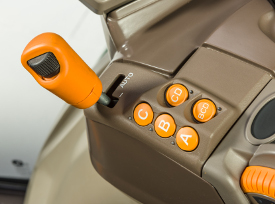 Command8 shift controls
Command8 shift controls
Range/gear controls
A single control lever, similar to the control used on the DirectDrive™ transmission on 6R and CommandQuad™ transmission on 7R, features an ergonomically designed and intuitive operator interface. This control lever provides manual gear and range change selection when in the left position, and auto selection when shifted to the right position. The thumbwheel is used to dial in the desired ground speed in the auto position.
Once the tractor is started, the operator selects a range by pressing one of the lettered range buttons on the right hand console. The operator has five different selections to choose from - A, B, C, and two multi-range modes (BCD and CD). When a range with a single letter is selected, gear shifting is allowed within the specified range. When a range with multiple letters is selected, operators can shift between the designated ranges simply by using the toggle lever.
The gear within the range can be selected by using the transmission control toggle lever to electronically shift to a desired gear. After setting the desired throttle position, the operator can move the left-hand reverser to the forward or reverse position to start movement. The operator can shift up or down through the gears in the selected range(s) as needed.
 Left-hand reverser
Left-hand reverser
Left-hand reverse
The electronic left-hand reverser is standard with all Command8 transmissions and provides neutral-to-gear modulation, which allows a quick, convenient, and smooth forward-reverse shuttle shifting at any speed. The shifter must be lifted from either park or neutral position to forward or reverse to activate. The parking brake is also electronically controlled through the left-hand reverser.
The left-hand reverser is a great feature for loader tractors. The operator's left hand can control easily tractor direction while the right hand manages the loader joystick and speed changes.
 Command8 in manual mode
Command8 in manual mode
Manual mode
The Command8 features two different ways to operate transmission range and speed selections. In manual mode, the operator has the ability to shift through speeds and ranges without clutching by moving the toggle lever forward, toward the + indicator, or backward, toward the - indicator. A single movement of the toggle lever changes one gear at a time. Holding the toggle lever in either direction increases accelerates gear changes throughout the range at a faster pace.
When in a multi-range mode, a simple double toggle of the lever moves to the next range.
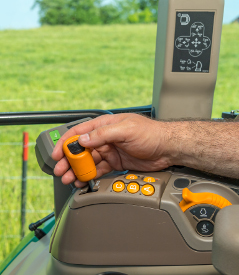 Command8 in auto mode
Command8 in auto mode
AUTO mode
Depending on load, auto mode will optimize both the engine and transmission by selecting the appropriate gear and rpm to optimize fuel efficiency. The only input needed from the operator is to set the target ground speed by using the thumbwheel. Once that target speed is set by the operator, the tractor takes care of maintaining that speed.
Once the operator has selected auto mode with the transmission shift lever, the following items will be displayed on the cornerpost display – auto activation, current ground speed, target ground speed, direction, range, and gear. If the operator has selected auto mode with the transmission control lever, then the operator can set the shift points of the transmission through the cornerpost display.
 Foot pedal lock switch
Foot pedal lock switch
Foot pedal lock
Similar to cruise control in a car, the foot pedal lock allows the operator to set a constant speed using the foot pedal. The switch to engage foot pedal lock is also located on the right-hand throttle control. To operate the feature, the hand throttle must be on the low throttle position. Use the foot control to increase the tractor to the desired travel speed, and then press the button to engage the foot pedal lock. When releasing the foot throttle, the tractor will then maintain the speed selected. It can be disengaged by either tapping the brakes, or moving the left hand reverser control to neutral or park.
Features available in both manual and AUTO mode
AutoClutch system
With AutoClutch, which is standard on all 5R Utility Tractors, the operator no longer has to use the clutch to control braking and re-engagement of the tractor if so desired. The clutch pedal is still on the tractor for those operators that still prefer to manually foot clutch. This provides the ultimate in ease of use.
AutoClutch allows the operator to bring the tractor to a complete stop without clutching, while at the same time does not overload the engine. It also provides the ability to inch or creep the tractor forward or reverse on a level surface or incline. And it provides the ability to accelerate the vehicle back to normal speed when releasing the brake.
The operator can set the sensitivity setting of the AutoClutch system in the cornerpost display. There are three modes available:
- High sensitivity (default mode)
- Off – temporary setting only that is reset after a key cycle
- Low sensitivity
Low sensitivity would be typically used in transport applications with a towed implement. The low sensitivity ensures that the tractor and implement are stretched for better traction control.
Speed matching
When shifting ranges in a multi-range mode (BCD, CD), the transmission will shift to a gear that most closely matches the speed in the range from which the operator is shifting from, which improves operator comfort by making a smoother transition into a new range. There are two types of speed matching, passive and active.
With passive speed matching, when shifting to a new range, the tractor shifts to a selected fixed gear in the new range based on transmission ratios. For example, when shifting from C8 to D range, instead of shifting into D8 when the range is changed to D like a mechanically controlled transmission would do, the transmission shifts to a preset range and gear of D2. This most closely matches the transmission ratio from which the operator is coming from.
Active speed matching shifts up or down based on wheel speed during range shifts. This minimizes acceleration or deceleration when the clutch re-engages after a range shift and keeps a more consistent ground speed, improving operator comfort.
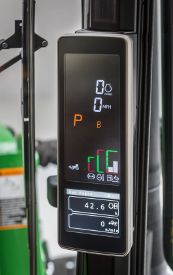 PowrReverser modulation settings in cornerpost display
PowrReverser modulation settings in cornerpost display
PowrReverser modulation
Similar to the 5M Utility Tractors, which offer a PowrReverser modulation dial to set aggressiveness of change in direction, all 5R Utility Tractors also offer PowrReverser modulation. Rather than a physical dial, the aggressiveness can be set through the cornerpost display. Settings can be set from 1 to 10, with 1 being the least aggressive direction change and 10 being the most aggressive direction change. A setting of 10 is popular for loader bucket applications where quicker directional changes are acceptable and more productivity is desired. Less aggressive modulation settings are ideal where smoother directional changes are required, such as bale stacking and pallet fork activities.
Start gear selection
Starting within gear 1 within every range has a negative impact on productivity. To minimize the amount of shifting required by the operator in many applications, start gears can be programmed by the operator when operating in any of the two multi-range modes.
In range CD, any start gear can be programmed into the cornerpost display between C1 and D1. In range BCD, any start gear can be programmed between B1 and D1. Let’s say that an operator programs B8 as the start gear for BCD range. This means that anytime the operator selects BCD mode by pressing that particular range button, the tractor will automatically begin in gear B8. The operator can of course shift to any range and gear between B1 and D8 from there, but the starting point will be what the operator has programmed. This results in less shifting and more productivity.
Within the fixed ranges (A, B, C), the preset start gears are A8, B8, and C4. These cannot be altered by the operator through the cornerpost display.
Independent programmable forward/reverse ratio
This feature is helpful in cyclical operations, such as loader work, where the operator wants to control the forward speed as a ratio of the reverse speed.
In manual mode, the tractor automatically selects a gear closest to the ratio desired by the operator. In auto mode, the tractor would adjust the set speed in the opposite direction. Ratios can be programmed up to 100 percent faster than the forward speed or up to 80 percent slower than the forward speed within the cornerpost display. This is adjustable in 20 percent increments (Forward speed x 0.20, 0.40, 0.60, 0.80, 1.00, 1.20, 1.40, 1.60, 1.80, 2.00).
Another selection is independent; in this mode the tractor remembers the last forward and reverse gear setting. Once the gear is manually changed in the reverse direction, the gear will automatically go back to the last gear when changing directions. If the gear is not manually changed when in reverse direction, then the forward gear and reverse gear will remain the same when changing directions.
While the maximum forward ground speed is 40 km/h (25 mph), the maximum reverse speed is 30 km/h (18.6 mph).
Load anticipation
A load anticipation feature is standard equipment on all tractors equipped with a Command8 transmission. Its primary function is to increase productivity and provide more operator comfort by assisting the operator to handle expected high-load situations by automatically increasing the fuel economy optimal engine speed when working with implements. It can be used in both PTO and hitch activities, and can be turned on or off for each within the cornerpost display.
If turned on through the display, load anticipation is activated when:
- PTO turned on – engine speed automatically increases to the maximum engine speed
- Hitch movement – engine speed automatically increases to 1500 rpm when a hitch movement is detected
The load anticipation feature also activates when using PTO or hitch functions programmed within iTEC™ system sequences.
Features available in auto mode only (Efficiency Manager™ feature)
Efficiency Manager is automatically enabled when the shift lever is placed in the automatic mode gate. The set speed adjuster on the top of the single lever gear selector allows the operator to dial in the desired ground speed to establish a set speed for forward and reverse. Efficiency Manager allows the transmission to up- or down-shift and change engine rpm to maintain the set wheel speed. To reach the desired set speed, the throttle must be set to full engine rpm. This allows Efficiency Manager to shift the transmission and adjust engine speed to maintain the desired wheel speed.
Eco on / Eco off
In some applications an operator may want to manage parameters for shifting points and minimum engine rpm. This can be accomplished with settings within the cornerpost display via Eco mode. Eco mode can be turned off and on with a switch located on the hand throttle. In many cases, operators will choose to utilize Eco mode in lower load conditions, such as transport. For tough field conditions, Eco mode is typically turned off. Minimum engine speed is adjustable between 900 and 2100 rpm.
Eco mode allows the operator to program two minimum engine speeds, one for when Eco is turned off, and one for when Eco is turned on. When Eco mode is activated, the transmission and engine will shift up and throttle back in order to try to maintain ground speed at the low engine rpm selected by the operator. For example, if a grower chooses a target speed of 12 km/h at an engine speed of 1200 rpm. The transmission and engine will work together to shift to higher gears and throttle back to find a gear that is able to get close to the 1200 rpm target.
When the grower gets to the field and wants to increase engine rpm to handle working tasks, simply turn Eco off with the Eco button on the throttle control, and the transmission and engine will then shift down and throttle up. The tractor will again target the speed selected via the thumbwheel, and the engine rpm that has been programmed into the cornerpost display for Eco off.
This is an excellent way to maximize fuel efficiency on a 5R Utility Tractor.
Load control droop
Load control droop allows the operator to control the shift point of the tractor. The goal of auto mode is to prevent the engine pulling down below this preselected operating point by downshifting automatically. It commands an upshift so that the engine speed is above the load control set point (droop) with sufficient torque reserve. It also commands a downshift when the engine speed is pulled down below the load control set point (droop). The load control droop can be set within the cornerpost display in two modes, PTO on and PTO off.
The settings the operator can choose from in the cornerpost display are:
- PTO on
- High droop
- Medium droop
- Low droop
- PTO off
- High droop
- Medium droop
- Low droop
Selecting high droop minimizes shifting, while selecting low droop provides faster reaction to load.


